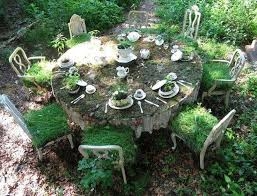
For one reason or another, I ignored the back garden for about four months, until a new puppy entered my life. Watching her discover the garden was fun until the day she popped out of the jungle, tail wagging, dragging a long piece of PVC pipe with a sprinkler head attached. PVC makes the perfect teething toy.
It was time to assess the damage. I couldn't see the pergola, and rambler roses were rambling through the outdoor furniture. I needed to do some shovel pruning.
Last year I planted a one-gallon Verbena rigida, a vigorous perennial that grew to cover a twenty-foot path. Eventually I forgot the path was there. This tough plant has rough leaves, grows two feet high and four feet wide, and sends out stems that root easily anywhere. The flowers are a lovely periwinkle blue but not worth the loss of a five-foot-wide path. I sent most of these plants to the yard-waste bin, but I may not be done yet as it is almost impossible to remove all the roots.
Another plant I love to hate is Jasminumpolyanthum, or pink jasmine, a favorite climber for many gardeners. A fast grower, it will soon reach 20 feet or more. If it outgrows its boundaries, it will grow down over itself, then under fences for the neighbors to handle, or into trees or anything that doesn't move. Grappling with its extreme twining tendencies can be a full-time job that never seems to end. A better choice would be the fragrant star jasmine (Trachelospermumjasminoides), an evergreen with dark shiny leaves. It makes a versatile shrub, ground cover or vine.
A visiting bird probably dropped the wild morning glory seed in my garden. Now the vine fills any spot available, plus it also twines around rose canes and other shrubs. Its roots cannot be pulled out. A troublesome weed, it doesn't seem to have a designated growing season. It's always there, alive and healthy.
If you purchase any of these plants, you will also need good pruning shears and protective garden gloves.
When I say shovel pruning, I mean roots and all—giving the whole plant the heave-ho. Recently, I started by digging out three roses that were almost totally tied up in wild morning glory stems. I put the rose canes in the yard-waste bin, not the compost pile, because thorns don't readily decompose. If you're shovel-pruning roses, be sure to get all the old roots out as these plants are determined to keep growing. I have transplanted many rose shrubs over the years and often noticed new canes emerging in the old location.
Many of us gardeners have a tendency to buy anything new in the market even though we don't have space in our gardens. We need to read the label to know the height and width of the mature plant, and the width and depth of the mature root ball as well. Citrus roots grow several feet beyond the canopy of a mature tree. Japanese maples produce a mass of shallow feeder roots. These roots need room and should not be disturbed by walking or planting in them.
Many trees have shallow feeder roots and many are invasive, heaving sidewalks, driveways and foundations and breaking sprinkler systems. The city has a list of street-friendly trees. Reading a tree's label before you buy it may save you hefty plumbing bills in the future.
Plants need oxygen, water and light to thrive. Once you have removed fallen foliage in your landscape, air circulation improves, sunlight warms the soil and millions of weed seeds begin to germinate. One good rain and any bare patches will come alive with fast-growing seedlings. Prevent this weed explosion now by smothering them with a three-inch-deep blanket of organic mulch, or bark mixed with well-aged manure. These materials will slowly decompose, enriching the soil and adding nutrients. Like a lovely tablecloth, the new mulch enhances the whole yard.
After your autumn cleanup, unleash your creativity. Add bird baths or terra cotta plant saucers filled with muddy water to attract butterflies. Fill bare areas with sculptures, whirligigs or other garden art. Consider placing large boulders for visual interest or creating a path made from local stone or a faux stream that meanders down a slight rise. How about a table-height planter for growing lettuces? Your imagination is your signature; the garden is your space. After all that work, place a bench along a path where you can sit and watch the birds or a new puppy at play.
Workshop: Napa County Master Gardeners will conduct a workshop on “Creating Wreaths from Your Garden” on Sunday, December 7, from 2 p.m. to 4 p.m., at the Yountville Community Center, 6516 Washington Street, Yountville.Learn which plants from your garden make good wreaths. Learn how to choose and prepare plant materials, and tips and tricks for designing and making easy wreaths for the holidays or other times of the year. Participants will create their own wreath to take home. To register, call the Parks & Recreation Department at 707-944-8712 or visit its website.
Master Gardeners are volunteers who help the University of California reach the gardening public with home gardening information. Napa County Master Gardeners ( http://ucanr.org/ucmgnapa/) are available to answer gardening questions in person or by phone, Monday, Wednesday and Friday, 9 a.m. to Noon, at the U. C. Cooperative Extension office, 1710 Soscol Avenue, Suite 4, Napa, 707-253-4143, or from outside City of Napa toll-free at 877-279-3065. Or e-mail your garden questions by following the guidelines on our web site. Click on Napa, then on Have Garden Questions? Find us on Facebook under UC Master Gardeners of Napa County.